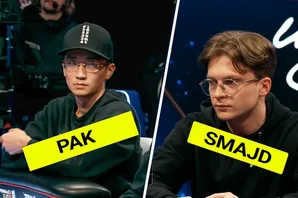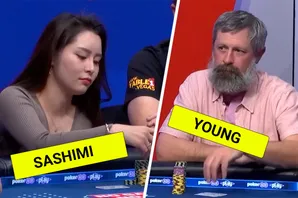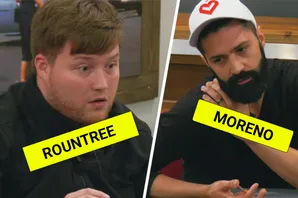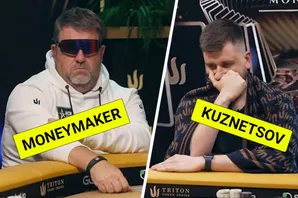If you’re paying attention to the chatter in the poker world these days, you’ve probably heard the word “target” mentioned (Andrew Brokos, I’m looking at you). It’s an important concept and worth discussing in these pages.
“Targeting” is the idea that when you make a bet or raise (whether for value or as a bluff), you should have an idea of what hands you want to call (or fold).
Targeting example
From the cutoff position, you raise to four big blinds with AK and just the big blind calls. Let’s assume that the starting stacks are 100 big blinds each. The flop is a pleasing A-7-4 rainbow. The villain checks, you bet 1/3 of the pot, and they call.
The turn is a nine, putting a flush draw on the board. The villain checks, you bet 2/3 of the pot, and the villain calls.
Now the river pairs the nine, so the flush draw misses. The board is A-7-4-9-9 with no flush possible. You still have top pair, top kicker. The villain checks for a third time. You turn to me (it’s an unusual game – “Two players to a hand”) and say, “Should I bet again?”
My question to you: “Well, do you think you have the best hand?”
“Yes. I think I have the best here almost always. So if I’m betting, it’s for value, not as a bluff.”
“Good, I agree. Now, if you bet for value, what worse hands will call you?”
This is targeting. If you put out a bet that you believe to be for value, you should be able to name some worse hands that could reasonably call your bet.
You pause for a moment, and say, “Well, all the worse aces.”
Excellent reply! It is quite reasonable to think that the villain could have an ace. The good news for us is that we have the bestest of all possible aces. And in fact, with the board coming running nines, we’ve just counterfeited A7 and A4 – we have the best two pair possible. So yes, it is almost obligatory for you to put out a river bet. You can name a big bucket of hands (all the other aces) that your opponent might well play this way, and would have difficulty folding.
How much to bet?
This is the other place where targeting is crucial. To decide how much to bet – again, whether it’s a value bet or a bluff – you must think about the hands you want to call.
In our example, your target is all the weaker aces (AQ, AJ, etc). That’s good news for us because they are very good hands (top pair, good kicker) that just happen to be worse than our hand. So we can bet a chunky amount – 2/3 to 3/4 pot is a reasonable sizing. Why? Because we’re targeting a strong range of hands – many hold’em players have difficulty folding top pair with a good kicker.
A bluffing example
Suppose we raise to four big blinds (4 BBs) in middle position with Q♠ J♠ , and just the small blind (SB) calls. Again, the stacks are 100 BBs. With 9 BBs in the pot, the flop is 2♠ 8❤️ 9♠ , giving us a flush draw, a gutshot to the nuts with a ten, and two overcards. The SB checks, we bet 3 BBs (1/3 pot), and the SB calls. This is a hand where we might well choose to bluff all three streets if we don’t hit an out at some point.
Now there’s 15 BBs in the pot. The turn is the 3♣ , changing nothing, and again, the SB checks. We decide that we are indeed going to plow forward, so we bet ten BBs (2/3 pot). We’re targeting already. We are hoping to get them to fold hands such as A8 and 77. It’s probably too much to ask them to fold top pair yet. The SB pauses, thinks about it for a while, but ultimately calls again. We could certainly use some help.
Well, we get help, but not a lot. There are 35 BBs in the pot, and the river is the A♣, whiffing all of our outs. However, it is a card that is much more likely to help us than help the villain. The further good news is that the SB checks once more.
We think that if the villain had a strong hand, better than one pair, they would have bet out or check-raised at some point. Since they didn’t do that, we’re inclined to put them on a draw, or a hand such as a pair of 9’s.
You turn to me (again, we’re in that weird, “Two players to a hand” world), “Think we should fire a third barrel?”
You don’t have to. It’s perfectly fine to check it down, and say, “So, is queen-high any good?” Oddly, it will be on occasion. If the villain had a draw such as JT or 76, we have the best hand. It’s quite rewarding to win at showdown with queen-high.
It’s also rare. There’s a pretty good chance that the villain has a pair of some sort, a 9 most frequently. If they have a pair of 9’s or 8’s, or a pocket pair such as 77, that ace will not make them happy, oh no, it won’t. We could have been plowing forward with the ace-high flush draw, which missed, but accidentally made top pair by hitting the ace. That, of course, now beats any pair of 9’s or 8’s, or 77 that the SB has.
You say, “Well, maybe he hit the ace. We have to bet big to get him off an ace.”
Here’s my advice: Don’t do it. One of my first rules is, “Don’t try to push them off top pair.” If they got sticky with an ace, they didn’t get sticky to then fold when the ace came. Maybe they had the ace-high flush draw (ooooh, that would have been bad for us) and they’re the one that just backed into top pair.
Whatever, if they have an ace, I expect them to call our bet, and I don’t want to bet the amount that we’d need to have any chance of an ace folding. There’s too good a chance that we’d be lighting a lot of chips on fire.
However. However… Those T9, 87, K9, K8, 77, 66 hands. Those look like promising targets for a medium-sized bluff. There’s 35 BBs in the pot, and if we really did hit that ace, how much would we bet? Well, interestingly, we’d be targeting those same general hands, but for value. Here, I would bet an amount that looks like we’re going for value against those very hands. Half pot (18 BBs) seems just about right. If they have a draw such as JT or 76, they’re going to snap fold, but we don’t care because we would have won at showdown. But that bet might be enough to get a pair of 9’s to fold, and should be successful often enough to justify the risk.
The key point, though, is that we’re targeting hands. In both the value-bet and bluffing examples, we have a clear picture of the hands we expect to call, and those that we expect to fold. And we’re sizing our bets accordingly.
“Targeting” – it’s not just a buzz phrase, it’s a really good idea.

































